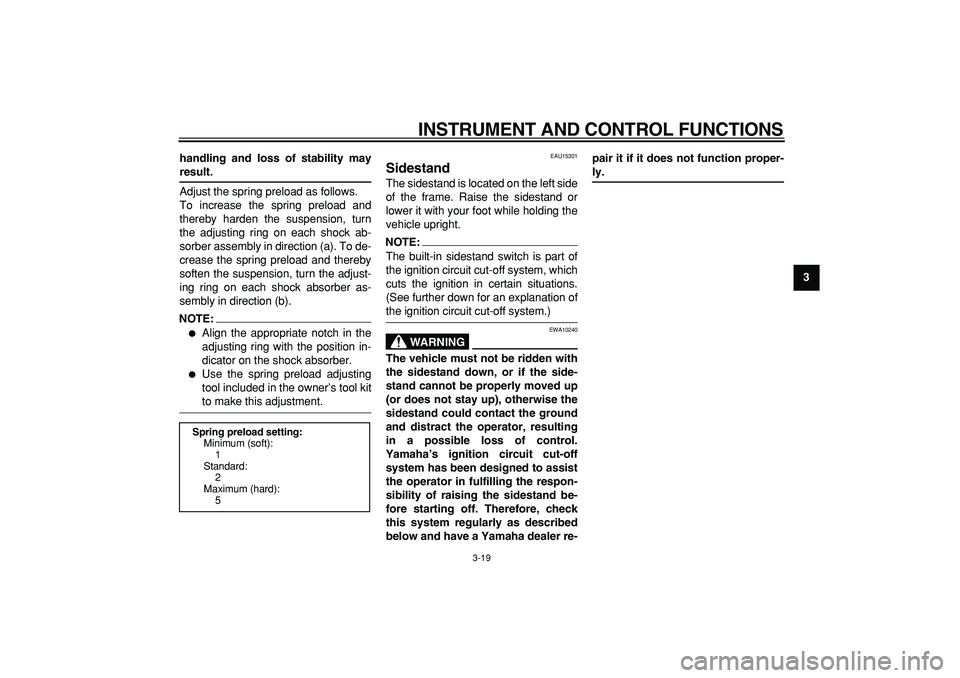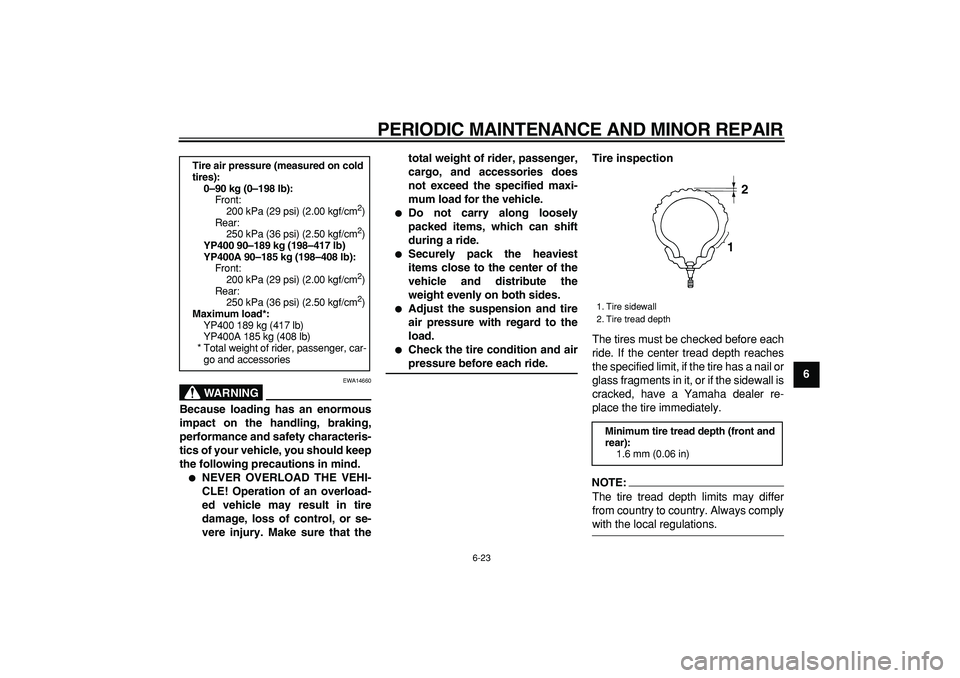Page 35 of 98

INSTRUMENT AND CONTROL FUNCTIONS
3-19
2
34
5
6
7
8
9 handling and loss of stability may
result.
Adjust the spring preload as follows.
To increase the spring preload and
thereby harden the suspension, turn
the adjusting ring on each shock ab-
sorber assembly in direction (a). To de-
crease the spring preload and thereby
soften the suspension, turn the adjust-
ing ring on each shock absorber as-
sembly in direction (b).
NOTE:
�
Align the appropriate notch in the
adjusting ring with the position in-
dicator on the shock absorber.
�
Use the spring preload adjusting
tool included in the owner’s tool kit
to make this adjustment.
EAU15301
Sidestand
The sidestand is located on the left side
of the frame. Raise the sidestand or
lower it with your foot while holding the
vehicle upright.
NOTE:
The built-in sidestand switch is part of
the ignition circuit cut-off system, which
cuts the ignition in certain situations.
(See further down for an explanation of
the ignition circuit cut-off system.)
WARNING
EWA10240
The vehicle must not be ridden with
the sidestand down, or if the side-
stand cannot be properly moved up
(or does not stay up), otherwise the
sidestand could contact the ground
and distract the operator, resulting
in a possible loss of control.
Yamaha’s ignition circuit cut-off
system has been designed to assist
the operator in fulfilling the respon-
sibility of raising the sidestand be-
fore starting off. Therefore, check
this system regularly as described
below and have a Yamaha dealer re-pair it if it does not function proper-
ly.
Spring preload setting:
Minimum (soft):
1
Standard:
2
Maximum (hard):
5
Page 67 of 98

PERIODIC MAINTENANCE AND MINOR REPAIR
6-23
2
3
4
5
67
8
9
WARNING
EWA14660
Because loading has an enormous
impact on the handling, braking,
performance and safety characteris-
tics of your vehicle, you should keep
the following precautions in mind.
�
NEVER OVERLOAD THE VEHI-
CLE! Operation of an overload-
ed vehicle may result in tire
damage, loss of control, or se-
vere injury. Make sure that thetotal weight of rider, passenger,
cargo, and accessories does
not exceed the specified maxi-
mum load for the vehicle.
�
Do not carry along loosely
packed items, which can shift
during a ride.
�
Securely pack the heaviest
items close to the center of the
vehicle and distribute the
weight evenly on both sides.
�
Adjust the suspension and tire
air pressure with regard to the
load.
�
Check the tire condition and air
pressure before each ride.Tire inspection
The tires must be checked before each
ride. If the center tread depth reaches
the specified limit, if the tire has a nail or
glass fragments in it, or if the sidewall is
cracked, have a Yamaha dealer re-
place the tire immediately.
NOTE:
The tire tread depth limits may differ
from country to country. Always comply
with the local regulations.
Tire air pressure (measured on cold
tires):
0–90 kg (0–198 lb):
Front:
200 kPa (29 psi) (2.00 kgf/cm
2
)
Rear:
250 kPa (36 psi) (2.50 kgf/cm
2
)
YP400 90–189 kg (198–417 lb)
YP400A 90–185 kg (198–408 lb):
Front:
200 kPa (29 psi) (2.00 kgf/cm
2
)
Rear:
250 kPa (36 psi) (2.50 kgf/cm
2
)
Maximum load*:
YP400 189 kg (417 lb)
YP400A 185 kg (408 lb)
* Total weight of rider, passenger, car-
go and accessories
1. Tire sidewall
2. Tire tread depth
Minimum tire tread depth (front and
rear):
1.6 mm (0.06 in)
12
Page 91 of 98

SPECIFICATIONS
8-2
2
3
4
5
6
7
89
Secondary reduction ratio:
42/16 (2.625)
Transmission type:
V-belt automatic
Operation:
Centrifugal automatic type
Chassis:
Frame type:
Aluminum die-cast and steel tube back-
bone
Caster angle:
27.00 °
Trail:
100.0 mm (3.94 in)
Front tire:
Type:
Tubeless
Size:
120/80-14M/C 58S
Manufacturer/model:
IRC/MB67
Manufacturer/model:
DUNLOP/D305FL
Rear tire:
Type:
Tubeless
Size:
150/70-13M/C 64S
Manufacturer/model:
IRC/MB67
Manufacturer/model:
DUNLOP/D305L
Loading:
Maximum load:
YP400 189 kg (417 lb)
YP400A 185 kg (408 lb)
* (Total weight of rider, passenger, cargo
and accessories)
Tire air pressure (measured on cold
tires):
Loading condition:
0–90 kg (0–198 lb)
Front:
200 kPa (29 psi) (2.00 kgf/cm
2
)
Rear:
250 kPa (36 psi) (2.50 kgf/cm
2
)
Loading condition:
YP400 90–189 kg (198–417 lb)
YP400A 90–185 kg (198–408 lb)
Front:
200 kPa (29 psi) (2.00 kgf/cm
2
)
Rear:
250 kPa (36 psi) (2.50 kgf/cm
2
)
Front wheel:
Wheel type:
Cast wheel
Rim size:
14M/C x MT3.00
Rear wheel:
Wheel type:
Cast wheel
Rim size:
13M/C x MT4.00
Front brake:
Type:
Dual disc brake
Operation:
Right hand operation
Recommended fluid:
DOT 4
Rear brake:
Type:
Single disc brake
Operation:
Left hand operation
Recommended fluid:
DOT 4
Front suspension:
Type:
Telescopic fork
Spring/shock absorber type:
Coil spring/oil damper
Wheel travel:
120.0 mm (4.72 in)
Rear suspension:
Type:
Unit swing
Spring/shock absorber type:
Coil spring/oil damper
Wheel travel:
104.0 mm (4.09 in)
Electrical system:
Ignition system:
Transistorized coil ignition (digital)
Charging system:
AC magneto